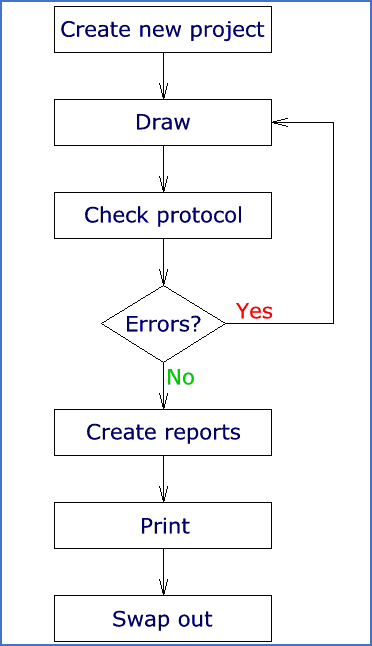|
<< Click to Display Table of Contents >> Work procedure |
  
|
|
<< Click to Display Table of Contents >> Work procedure |
  
|
This section is perhaps the most important part of the entire documentation! It describes the difference between success and failure.
The work procedure when using cadett ELSA in general is described by the figure below.

Figure 23: The cadett ELSA work procedure.
You start by creating a new project, i.e. you name the new documentation you are going to produce. Then you draw your drawing sheets. The concept of “drawing” should here be regarded in a very general way. Often you copy drawing sheets or circuits into the project. Anyway, in one way or another you make up your documentation. When you feel satisfied with what you have accomplished you investigate if there are any errors.
Therefore you check the so-called OnLine Protocol. This protocol is handled by OnLine and shows you, when you wish, which errors there currently are in your project. You will find that there are some faults and then you will return to your drawing sheets and correct them.
When you have done that you check the OnLine Protocol again and, hopefully, you have got rid of the errors. Maybe there have occurred new errors or you have failed to correct some of the old ones, or maybe you have forgotten some of them. In that case you will have to repeat the procedure and correct those mistakes. When you feel satisfied – there are no serious errors at present – you create your reports, plot the result and then finally you swap out – file – the project for future needs.
This might seem quite simple and right on target but there is a built in trap that is fairly simple to observe if you consider the figure above. The problem is that you risk ending up in an infinite checking and correcting of errors. The most common mistake is to wait far too long with checking the OnLine Protocol, which in turn will result in you getting heaped in errors. Often you will find simple errors made repeatedly over and over again. Even if it is simple to correct one or two of these errors the mere quantity makes it time-consuming and therefore difficult anyway.
Instead you should check the OnLine Protocol regularly. Only draw one sheet or maybe parts of a sheet before you check the protocol. You will then discover that you have made certain errors. You can then, quick and easy, make the necessary corrections and at the same time you will learn to work in a correct manor. You will then avoid 90, 95 or maybe even 99% of all faults and you will save an enormous amount of time.
Hence: This is tremendously important and indeed the difference between a successful use of this program and a total fiasco.
The story about Calvin Bigshot and Nicholas Planner is by this time more than fifteen years old and many are those who recognise themselves just about too much in this story. Anyway it is rendered here. Please read it and consider where you would like to find yourself in this story.